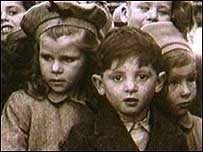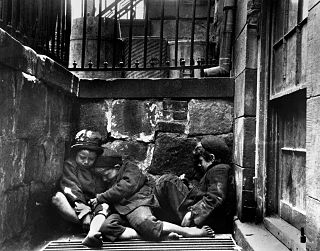Related Research Articles

A child (pl. children) is a human being between the stages of birth and puberty, or between the developmental period of infancy and puberty. It may also refer to an unborn human being. The legal definition of child generally refers to a minor, otherwise known as a person younger than the age of majority. Children generally have fewer rights and responsibilities than adults. They are generally classed as unable to make serious decisions.

Foster care is a system in which a minor has been placed into a ward, group home, or private home of a state-certified caregiver, referred to as a "foster parent", or with a family member approved by the state. The placement of a "foster child" is normally arranged through the government or a social service agency. The institution, group home, or foster parent is compensated for expenses unless with a family member.
A runaway is a minor or a person under a specified age who has left their parents or legal guardians without permission. Statistics show that females are more likely to run away than males.
Foster children in Canada are known as permanent wards. A ward is someone, in this case a child, placed under protection of a legal guardian and are the legal responsibility of the government. Census data from 2011 counted children in foster care for the first time, counting 47,885 children in care. The majority of foster children – 29,590, or about 62% – were aged 14 and under. The wards remain under the care of the government until they "age out of care." This age is different depending on the province.

Positive youth development (PYD) programs are designed to optimize youth developmental progress. This is sought through a positivistic approach that emphasizes the inherent potential, strengths, and capabilities youth hold. PYD differs from other approaches within youth development work in that it rejects an emphasis on trying to correct what is considered wrong with children's behavior or development, renouncing a problem-oriented lens. Instead, it seeks to cultivate various personal assets and external contexts known to be important to human development.
Child protection refers to the safeguarding of children from violence, exploitation, abuse, and neglect. It involves identifying signs of potential harm. This includes responding to allegations or suspicions of abuse, providing support and services to protect children, and holding those who have harmed them accountable.
Hospitalism was a pediatric diagnosis used in the 1930s to describe infants who wasted away while in a hospital. The symptoms could include decreased physical development and disruption of perceptual-motor skills and language. In the first half of the 20th century, hospitalism was discovered to be linked to social deprivation between an infant and its caregiver. The term was in use in 1945, but the term can be traced back as early as 1897.
Child protective services (CPS) is the name of an agency in many states of the United States responsible for providing child protection, which includes responding to reports of child abuse or neglect. Some states use other names, often attempting to reflect more family-centered practices, such as department of children and family services (DCFS). CPS is also sometimes known by the name of department of social services, though these terms more often have a broader meaning.
Transitional age youth can reference both a developmental period and be a descriptor regarding eligibility for certain services. While there are variations in definitions, the age ranges do consistently overlap and include late adolescence to early adulthood. This range is considered a critical period in human development characterized by several changes socially, environmentally, and cognitively. During this time, individuals can experience changes in their social roles and function, family and peer supports, exposure to substance use, educational and vocational programs, as well as changes in healthcare providers from pediatric to adult settings.

A residential treatment center (RTC), sometimes called a rehab, is a live-in health care facility providing therapy for substance use disorders, mental illness, or other behavioral problems. Residential treatment may be considered the "last-ditch" approach to treating abnormal psychology or psychopathology.

The Foster Care Independence Act of 1999 aims to assist youth aging out of foster care in the United States in obtaining and maintaining independent living skills. Youth aging out of foster care, or transitioning out of the formal foster care system, are one of the most vulnerable and disadvantaged populations. As youth age out of the foster care system at age 18, they are expected to become self-sufficient immediately, even though on average youth in the United States are not expected to reach self-sufficiency until age 26.
Institutional abuse is the maltreatment of a person from a system of power. This can range from acts similar to home-based child abuse, such as neglect, physical and sexual abuse, and hunger, to the effects of assistance programs working below acceptable service standards, or relying on harsh or unfair ways to modify behavior. Institutional abuse occurs within emergency care facilities such as foster homes, group homes, kinship care homes, and pre-adoptive homes. Children who are placed in this type of out of home care are typically in the custody of the state. The maltreatment is usually caused by an employee of the facility.
The Fostering Connections to Success and Increasing Adoptions Act of 2008 was an Act of Congress in the United States signed into law by President George W. Bush on October 7, 2008. It was previously unanimously passed in both the House of Representatives and in the Senate. The law made numerous changes to the child welfare system, mostly to Title IV-E of the Social Security Act, which covers federal payments to states for foster care and adoption assistance. According to child welfare experts and advocates, the law made the most significant federal improvements to the child welfare system in over a decade.

Deinstitutionalisation is the process of reforming child care systems and closing down orphanages and children's institutions, finding new placements for children currently resident and setting up replacement services to support vulnerable families in non-institutional ways. It became common place in many developed countries in the post war period. It has been taking place in Eastern Europe since the fall of communism and is now encouraged by the EU for new entrants. It is also starting to take hold in Africa and Asia although often at individual institutions rather than statewide. New systems generally cost less than those they replace as many more children are kept within their own family. Although these goals have been made internationally, they are actively being working towards as reform and new reforms are put into practice slowly as is fit for each country.

Foster care is the term used for a system in which a minor who has been made a ward is placed in an institution, group home, relative placement, or private home of a state certified caregiver. The placement of the child is usually arranged through the government or a social-service agency. The institution, group home, or foster parent is paid. The state via the family court and child protection agency stand in loco parentis to the minor, making all legal decisions, while the foster parent is responsible for the day-to-day care of the minor. The foster parent is remunerated by the state for their services.
Research shows that a disproportionate number of homeless youth in the United States identify as lesbian, gay, bisexual or transgender, or LGBT. Researchers suggest that this is primarily a result of hostility or abuse from the young people's families leading to eviction or running away. In addition, LGBT youth are often at greater risk for certain dangers while homeless, including being the victims of crime, risky sexual behavior, substance use disorders, and mental health concerns.
South Africa has one of the most extensive social welfare systems among developing countries in the world. In 2019, an estimated 18 million people received some form of social grant provided by the government.
Under normal circumstances, the United States child welfare systems is considered by experts to be underfunded and strains social workers with high case loads. However, during the 2020 COVID-19 pandemic, the U.S. experienced an unprecedented lockdown and national unemployment reached a record high. This presents an issue because it is recorded that during times of economic stress, child abuse skyrockets.
Jennifer Woolard is a developmental psychologist known for work within the juvenile justice system. Woolard is professor of psychology and adjunct professor of law at Georgetown University. She is involved in the Youth In Custody Practice Model Initiative at the Center for Juvenile Justice Reform at Georgetown University's McCourt School of Public Policy, which seeks to adopt evidence-based developmentally-appropriate practices within juvenile correctional institutions.
Obstacles to receiving mental health services among African American youth have been associated with stigma and shame, child-related factors, treatment affordability, availability, and accessibility, clinician and therapeutic factors, the school system, religion/spirituality, and social networks. When examining the prevalence rates of African American youth that have experienced cognitive and behavioral challenges, the underutilization of mental health services is startling. The National Comorbidity Survey-Adolescent Supplement revealed that 46.8% of African Americans under 18-years-old may have a mental health disorder. Additionally, African American children between the ages of five- and twelve-years old commit suicide at approximately double the rate of their White counterparts. Furthermore, the data from the Youth Risk Behavior Surveillance System (YRBSS) showed that Black students commit suicide at higher rates than White students. With all this information in mind, only three-quarters of African American children receive mental health care. 76.5% of African American youth from the ages of six to seventeen have mental health issues that need help, but their needs are not met. 50% to 75% of urban community-dwelling Black children and adolescents do not receive mental health care. A study showed that African American youth experiencing a major depressive episode are more unlikely to seek aid or speak to anyone about how they feel. 13% to 52% of African American child and adolescents who do not receive the mental health care that they need are at higher risk for detrimental health outcomes; hence, the importance of identifying the obstacles that may prevent unaddressed mental health service needs.
References
- ↑ Pittman, K. (1996) "Aging Out or Aging In?" Archived September 29, 2007, at the Wayback Machine Youth Today. January 1996. Retrieved 5/8/07.
- ↑ (2006) Trial Home Visits in Relation to "Aging Out of Foster Care" 624-10-01-40-05. State of North Dakota. Retrieved 5/8/07.
- ↑ (nd) [How Do I Prevent My Child From Losing Benefits at Age 21 ("Aging Out")?] United States Citizenship and Immigration Services. Retrieved 5/8/07.
- ↑ Brackett, E. (2005) Aging Out of Foster Care, Newshour television show, PBS. May 19, 2005. Retrieved 5/8/07.
- 1 2 3 4 5 Gypen, Laura; Vanderfaeillie, Johan; De Maeyer, Skrallan; Belenger, Laurence; Van Holen, Frank (May 2017). "Outcomes of children who grew up in foster care: Systematic-review". Children and Youth Services Review . 76: 74–83. doi:10.1016/j.childyouth.2017.02.035. ISSN 0190-7409.
- ↑ Dworsky, Amy; Napolitano, Laura; Courtney, Mark (December 2013). "Homelessness During the Transition From Foster Care to Adulthood". American Journal of Public Health . 103 (S2): S318–S323. doi:10.2105/ajph.2013.301455. ISSN 0090-0036. PMC 3969135 . PMID 24148065.
- 1 2 3 Pecora, Peter J.; Williams, Jason; Kessler, Ronald C.; Hiripi, Eva; O'Brien, Kirk; Emerson, John; Herrick, Mary A.; Torres, Dan (August 2006). "Assessing the educational achievements of adults who were formerly placed in family foster care". Child & Family Social Work. 11 (3): 220–231. doi:10.1111/j.1365-2206.2006.00429.x. ISSN 1356-7500.
- ↑ Jackson, Sonia; Cameron, Claire (June 2012). "Leaving care: Looking ahead and aiming higher". Children and Youth Services Review. 34 (6): 1107–1114. doi:10.1016/j.childyouth.2012.01.041. ISSN 0190-7409.
- ↑ Day, Angelique; Dworsky, Amy; Fogarty, Kieran; Damashek, Amy (November 2011). "An examination of post-secondary retention and graduation among foster care youth enrolled in a four-year university". Children and Youth Services Review. 33 (11): 2335–2341. doi:10.1016/j.childyouth.2011.08.004. ISSN 0190-7409.
- 1 2 Naccarato, Toni; Brophy, Megan; Courtney, Mark E. (July 2009). "WITHDRAWN: Employment outcomes of foster youth: The results from the Midwest evaluation of the adult functioning of foster youth". Children and Youth Services Review. doi:10.1016/j.childyouth.2009.07.017. ISSN 0190-7409.
- 1 2 (nd) Programs and Resources for Youth Aging Out of Foster Care Archived April 9, 2007, at the Wayback Machine . Child Welfare League of America. Retrieved May 8, 2007.
- ↑ (2005) Foster care – hope emerges. Reform efforts gain momentum. San Francisco Chronicle. 12/22/05. Retrieved 5/8/07.
- ↑ Rhodes, L. (2006) "Young writers finding a powerful voice. Archived 2007-05-02 at the Wayback Machine " Retrieved 5/8/07.
- ↑ "Archived copy" (PDF). Archived from the original (PDF) on 2009-11-05. Retrieved 2009-11-12.
{{cite web}}: CS1 maint: archived copy as title (link)